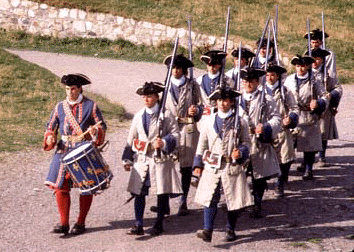
The Garrison
 Throughout the years of the French colonization of Louisbourg soldiers made up about one quarter of the town's population. This massive population was a combination of seven units, each having its own significant differences.
Throughout the years of the French colonization of Louisbourg soldiers made up about one quarter of the town's population. This massive population was a combination of seven units, each having its own significant differences.
The first was Compagnies Franches de la Marine which were independent companies of marine troops with no regimental structure. They served in Louisbourg from its founding in 1713, until its final capture in 1758. The number of companies and their size varied over the years and by the 1740s there were eight in the garrison with 70 men in each. However, not all of them were stationed in Louisbourg, some serving at Port Dauphin (Englishtown), Port Toulouse (St. Peter's) and Port La Joie (Charlottetown). During the second French occupation there were 24 companies with a combined total of 1200 men. Each company had its own captain and three junior officers.
Another unit was the Regiment de Karrer, a foreign mercenary unit of mostly Swiss and German soldiers which had only 50 men in 1722. However, by 1744 there were 150 men in the detachment at Louisbourg. This represented one half of Colonel Karrer's Company at Rochefort. These soldiers had special privileges accorded to them in their contract with the King. Some soldiers of this regiment were later identified as the ringleaders of the 1744 mutiny.
The Cannoniers-Bombardiers were the artillery specialists in Louisbourg. They were responsible for the firing of cannons and mortars. The company officially formed in 1743 with only 30 men and two officers. These soldiers did not participate in the 1744 mutiny. During the second occupation, this unit expanded to two companies with 60 men in each.
During the 1750s, representatives from four infantry regiments came to Louisbourg. These were the Regiment de Bourgogne, the Regiment d'Artois, the Regiment de Cambis and the Regiment de Volontaires Étrangers. The first two arrived in 1755 with 520 men in each battalion. The latter regiments came in 1758 just before the second siege and had 680 men in each.


